Unit 8 Have you read Treasure Island yet? Section A 3a-3c 课件(共23张PPT) 人教版八年级英语下册
文档属性
| 名称 | Unit 8 Have you read Treasure Island yet? Section A 3a-3c 课件(共23张PPT) 人教版八年级英语下册 | 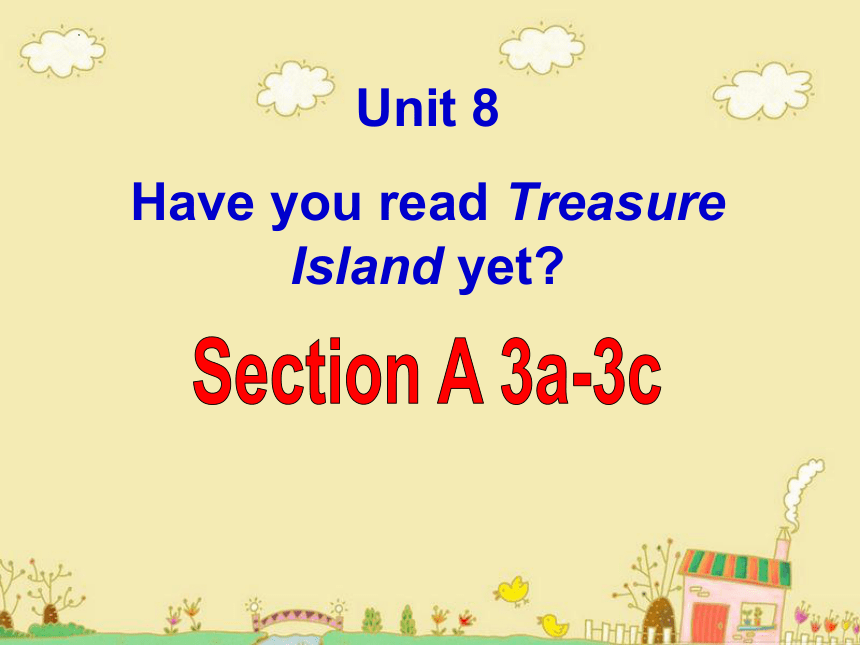 | |
| 格式 | pptx | ||
| 文件大小 | 2.2MB | ||
| 资源类型 | 教案 | ||
| 版本资源 | 人教新目标(Go for it)版 | ||
| 科目 | 英语 | ||
| 更新时间 | 2024-10-12 09:33:27 | ||
图片预览

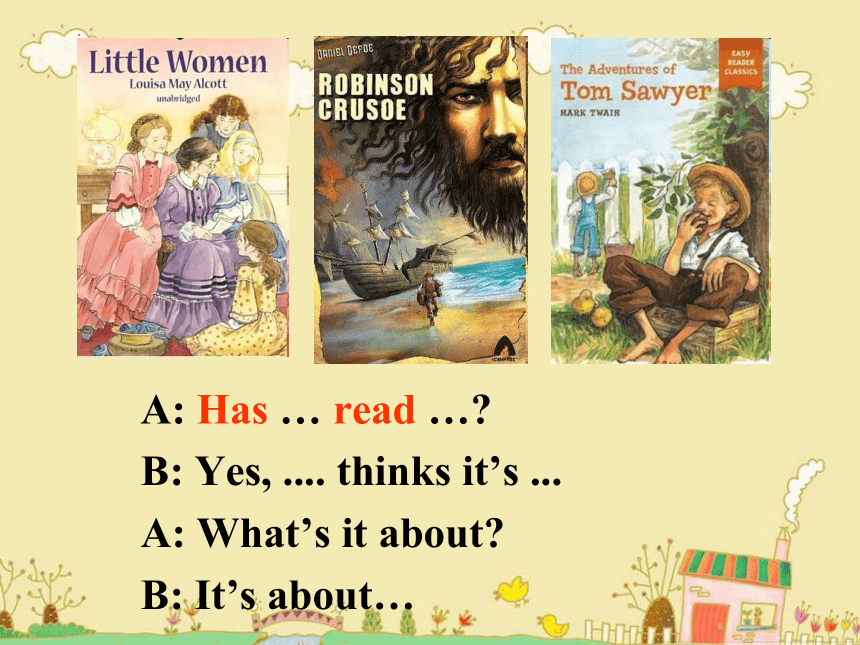
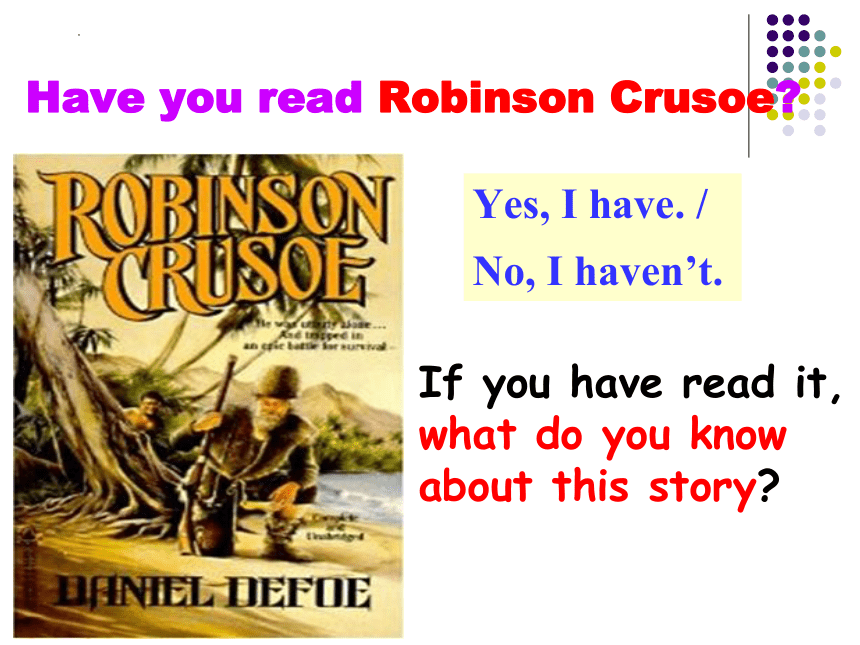
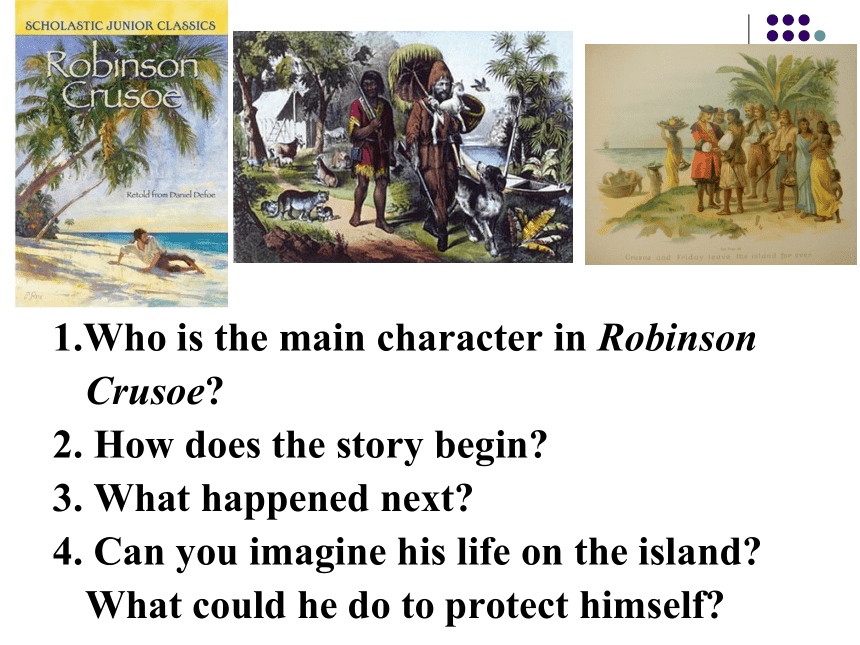
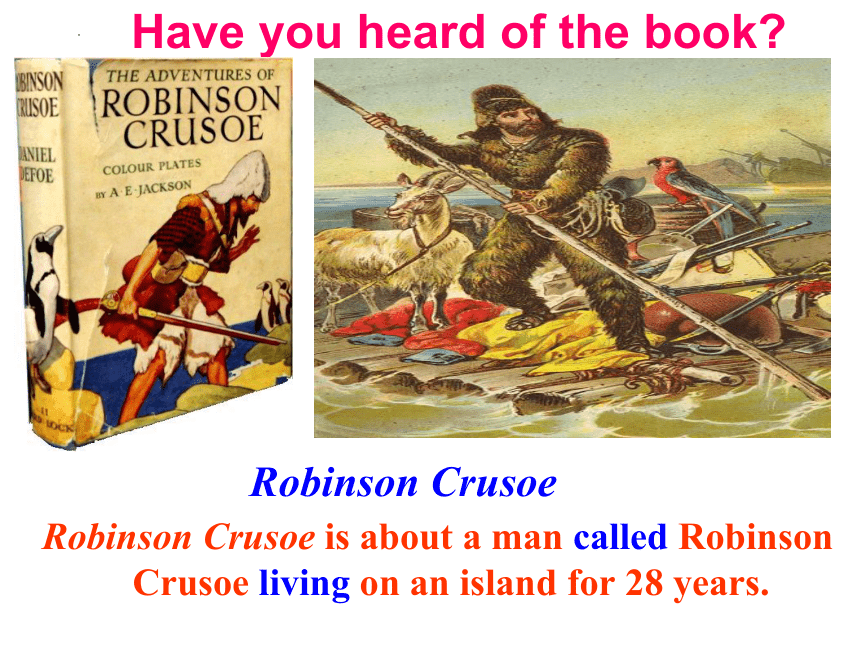
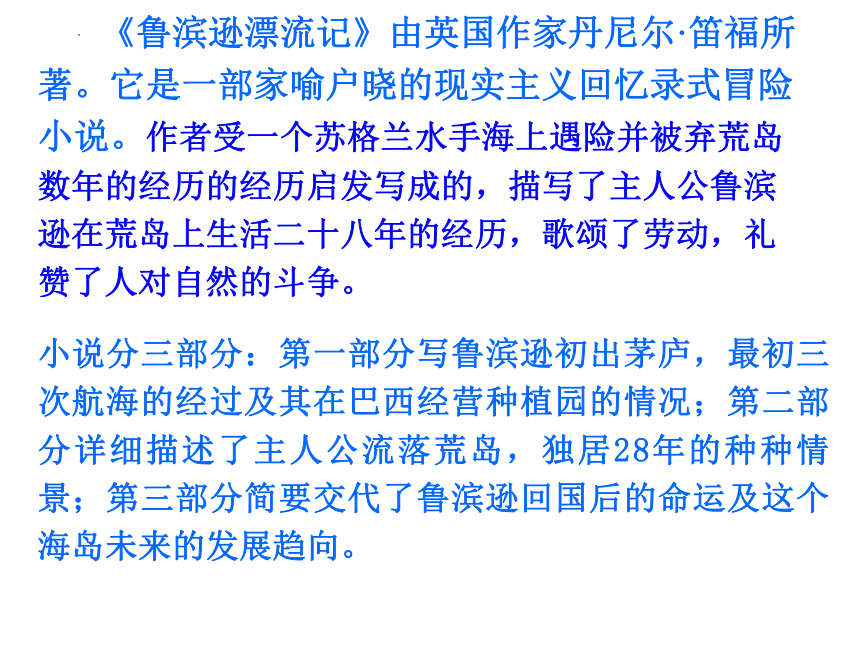
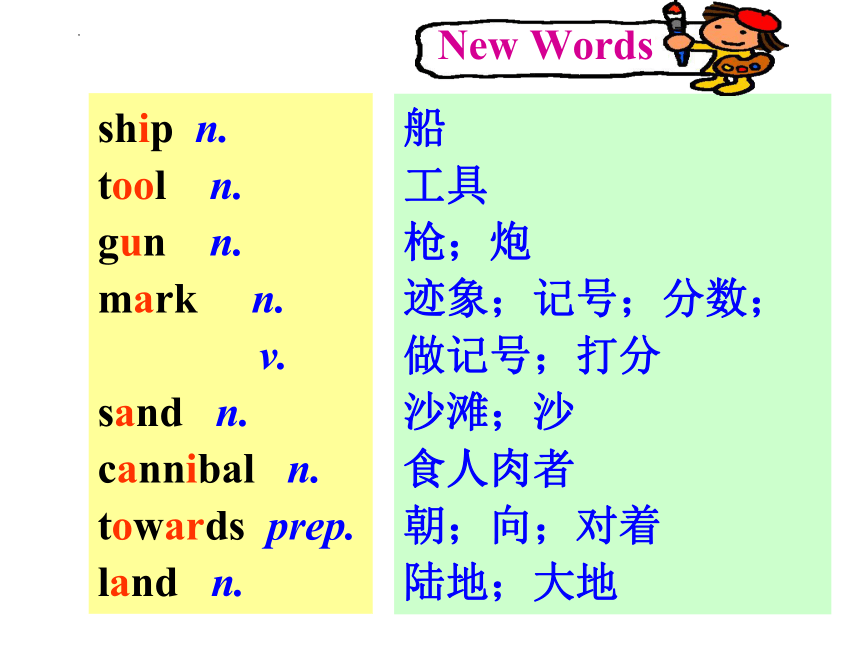
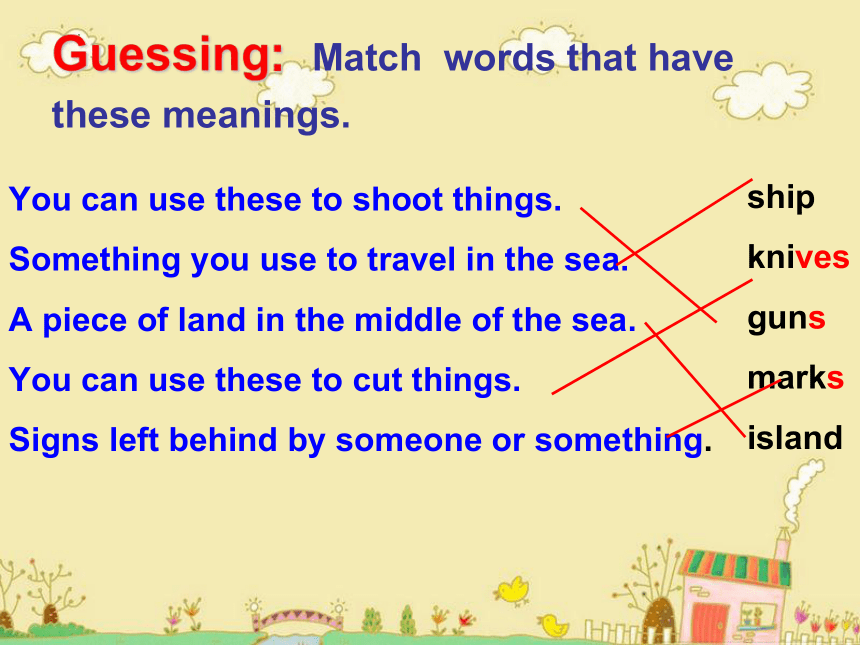
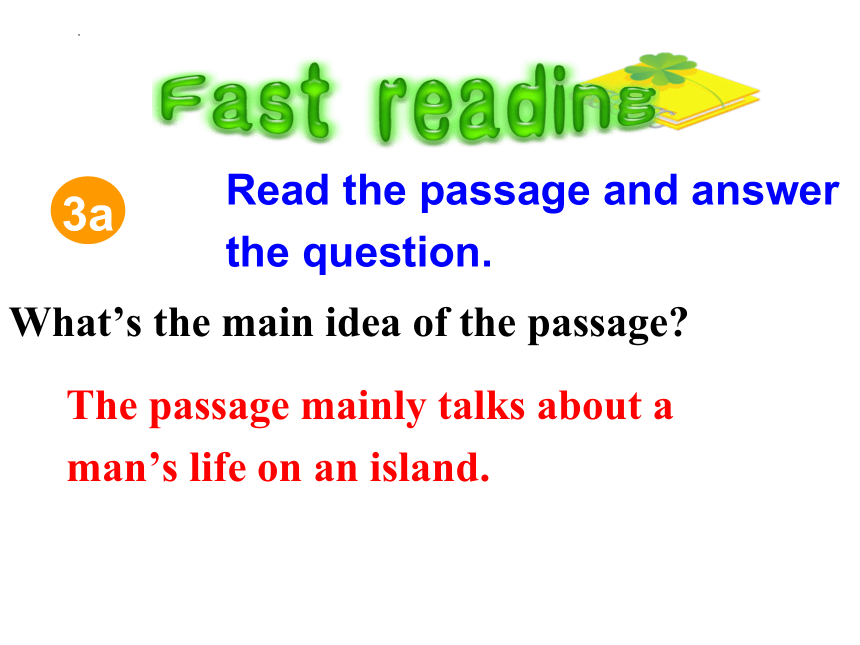
文档简介
(共23张PPT)
Unit 8
Have you read Treasure Island yet
Section A 3a-3c
A: Has … read …
B: Yes, .... thinks it’s ...
A: What’s it about
B: It’s about…
Have you read Robinson Crusoe
Yes, I have. /
No, I haven’t.
If you have read it, what do you know about this story
1.Who is the main character in Robinson Crusoe
2. How does the story begin
3. What happened next
4. Can you imagine his life on the island What could he do to protect himself
Robinson Crusoe
Have you heard of the book
Robinson Crusoe is about a man called Robinson Crusoe living on an island for 28 years.
《鲁滨逊漂流记》由英国作家丹尼尔·笛福所著。它是一部家喻户晓的现实主义回忆录式冒险小说。作者受一个苏格兰水手海上遇险并被弃荒岛数年的经历的经历启发写成的,描写了主人公鲁滨逊在荒岛上生活二十八年的经历,歌颂了劳动,礼赞了人对自然的斗争。
小说分三部分:第一部分写鲁滨逊初出茅庐,最初三次航海的经过及其在巴西经营种植园的情况;第二部分详细描述了主人公流落荒岛,独居28年的种种情景;第三部分简要交代了鲁滨逊回国后的命运及这个海岛未来的发展趋向。
ship n.
tool n.
gun n.
mark n.
v.
sand n.
cannibal n.
towards prep.
land n.
船
工具
枪;炮
迹象;记号;分数;
做记号;打分
沙滩;沙
食人肉者
朝;向;对着
陆地;大地
New Words
Guessing: Match words that have these meanings.
You can use these to shoot things.
Something you use to travel in the sea.
A piece of land in the middle of the sea.
You can use these to cut things.
Signs left behind by someone or something.
ship
knives
guns
marks
island
Read the passage and answer the question.
What’s the main idea of the passage
The passage mainly talks about a man’s life on an island.
3a
1. What does Robinson Crusoe wait for
When I first arrived on this island, I had nothing. But I’ve found the ship and made a small boat. I’ve brought back many things I can use---food and drink, tools, knives and guns. Although I have lost everything, I have not lost my life. So I will not give up and I will wait for another ship. I have already cut down trees and built a house. I go out with my gun almost every day to kill animals and birds for food. I’m even learning to grow fruit and vegetables.
2. Why does Robinson Crusoe call the man Friday
A few weeks ago, I found the marks of another man’s feet on the sand. Who else is on my island How long have they been here Not long after that, I saw some cannibals trying to kill two men from a broken ship. One of them died but the other ran towards my house. I helped him kill the cannibals. This man now lives with me and helps me. I named him Friday because that was the day I met him. He is smart and I have already taught him some English.
———————--------------------------------------------------------------------------------
—————
Correct the sentences.
3c
Robinson Crusoe arrived on the island with enough food and drink.
2. Friday made a small boat.
Robinson Crusoe arrived on the island with nothing.
Robinson
3. Robinson had some food and tools when he first arrived on the island.
4. Robinson used the ship to build his house.
Robinson had nothing when he first arrived on the island.
cut down trees
5. Friday saw some marks of another man’s feet on the beach.
6. Robinson tried to kill the two men.
Robinson saw some marks of another man’s feet on the beach.
Some cannibals tried to kill the two men.
arrive on this island
make a boat
bring back
give up
wait for
cut down
build a house
到达这个岛
制作船
带回来
放弃
等候
砍倒
建房子
kill … for food
the marks of
another man’s feet
who else
see sb. doing sth.
run towards
help sb. do sth.
name sb. …
teach sb. sth.
杀死……作为食物
另一个人的脚印
还有谁
看见某人正在做某事
朝……跑
帮助某人做某事
给某人起名为……
教某人某事
Grammar Focus
Have you ______ Little Women yet Yes, ______./No, _______.
Has Tina read _______yet Yes, ______. She _____ it's _______.
Have you _____ which book __________yet Yes, _____. I________it. It was _______.
现在完成时:表示过去发生或已经完成的某一动作对现在造成的影响或结果,或从过去开始一直延续到现在的动作或保存的状态。
结构: 主语+ have / has + 动词的过去分词
一般疑问句:have / has … Yes, I/he/she have. No, I/he/she haven’t.
特殊疑问句:特殊疑问词 + have / has + 主语+过去分词 (+ 其他)
What have you just finished
否定句:主语 + have / has + not + 过去分词(+ 其他)
1. 现在完成时动词构成
have /has + v 过去分词
助动词
否定
haven’t
hasn’t
疑问
Have you…
Has he…
常与下列时间状语连用:just , already, yet,
ever, never, before, several times
过去分词变化规则:(过去式和过去分词的变化相同)
规则变化:
1. 一般在动词词尾直接加ed。如:
pick → picked → picked;
wish → wished → wished;
stay → stayed → stayed
2. 以不发音的e结尾的动词后面加d。如:
like → liked → liked;
hope → hoped → hoped;
phone → phoned → phoned
3. 以“辅音字母+y”结尾的动词, 变y为i, 再加-ed. 如:
study → studied → studied;
hurry → hurried → hurried;
reply → replied → replied
4. 词尾只有一个辅音字母的重读闭音节动词,要双写辅音字母,再加-ed。如:
stop → stopped → stopped;
clap → clapped → clapped
不规则变化:
5. 以不变应万变。如:
let → let → let;
put → put → put;
read → read → read
6. 若中间有双写e,则去掉一个e,单词末尾再加t。如:
feel → felt → felt;
keep → kept → kept;
sleep → slept → slept
7. 结尾的字母d变t。如:
lend → lent → lent;
build → built → built;
send → sent → sent
8. 变为以-ought或-aught结尾。如:
buy → bought → bought;
bring → brought → brought;
catch → caught → caught;
teach → taught → taught
had breakfast
moved here
in 2011
现在完成时
1.过去发生的动作对现在造成的影响或结果。和already, never, ever, just, before, yet, so far 等状语连用。
2.过去已经开始,持续到现在的动作或状态,
常与for或since引起的一段时间状语连用。
动词构成:have/has+v过去分词
I have just had my breakfast.
(现在我不饿)
I’m not hungry now
I still live here
I have lived here for three years.
I have lived here since 2011 / three years ago.
now
past
1. yet常用于现在完成时的一般疑问句或否定句的句末。用于疑问句时,意为“已经”;用于否定句时,意为“还”。
2.not yet 常用在答语中,意为“尚未;还没有”
already 一般用于肯定句,常放于句中,实义动词之前,助动词之后。用于疑问句时表示惊讶,出乎意料。
3. for+表示一段时间的短语
4. since+表示过去时间点的词语
since+表示过去时间的时间状语从句
since+一段时间+ago
注意: come, go, leave, arrive, buy, lose, receive, join, die, buy 和 marry 等动词所表示的动作是一时的, 不能延续的, 故不能与for …, since …等开头的表示一段时间的状语连用。不过, 这些词用于否定句则可以与表示持续的时间状语连用,即动作的不发生是可以持续的。
比较现在完成时和过去时的区别:
*现在完成时所表示的是过去的发生的动作对现在造成的影响和结果,强调的是现在的情况,所以不能和表示过去的时间状语连用,如:yesterday,last night, three weeks ago, in 1990。
*一般过去时表示的是过去发生的动作或状态,和现在不发生联系,它可以和表示过去的时间状语连用。
I have seen the film.(我了解这部电影的内容。)
I saw the film last week.(只说明上星期看了这部电影,不涉及现在的情况。)
注意: 现在完成时不能和明确指出时间的状语
(如: yesterday, last, year, in 1976, two days
ago, just now, when she came in 等)连用,
但可以和不明确指出时间的状语(如: already,
yet, ever, never, sometimes, always, often,
before, once, twice, recently, lately等)连用;
也可以和表示包括现在在内的时间状语(如:
today, this morning, this week, this year等)连用。
Unit 8
Have you read Treasure Island yet
Section A 3a-3c
A: Has … read …
B: Yes, .... thinks it’s ...
A: What’s it about
B: It’s about…
Have you read Robinson Crusoe
Yes, I have. /
No, I haven’t.
If you have read it, what do you know about this story
1.Who is the main character in Robinson Crusoe
2. How does the story begin
3. What happened next
4. Can you imagine his life on the island What could he do to protect himself
Robinson Crusoe
Have you heard of the book
Robinson Crusoe is about a man called Robinson Crusoe living on an island for 28 years.
《鲁滨逊漂流记》由英国作家丹尼尔·笛福所著。它是一部家喻户晓的现实主义回忆录式冒险小说。作者受一个苏格兰水手海上遇险并被弃荒岛数年的经历的经历启发写成的,描写了主人公鲁滨逊在荒岛上生活二十八年的经历,歌颂了劳动,礼赞了人对自然的斗争。
小说分三部分:第一部分写鲁滨逊初出茅庐,最初三次航海的经过及其在巴西经营种植园的情况;第二部分详细描述了主人公流落荒岛,独居28年的种种情景;第三部分简要交代了鲁滨逊回国后的命运及这个海岛未来的发展趋向。
ship n.
tool n.
gun n.
mark n.
v.
sand n.
cannibal n.
towards prep.
land n.
船
工具
枪;炮
迹象;记号;分数;
做记号;打分
沙滩;沙
食人肉者
朝;向;对着
陆地;大地
New Words
Guessing: Match words that have these meanings.
You can use these to shoot things.
Something you use to travel in the sea.
A piece of land in the middle of the sea.
You can use these to cut things.
Signs left behind by someone or something.
ship
knives
guns
marks
island
Read the passage and answer the question.
What’s the main idea of the passage
The passage mainly talks about a man’s life on an island.
3a
1. What does Robinson Crusoe wait for
When I first arrived on this island, I had nothing. But I’ve found the ship and made a small boat. I’ve brought back many things I can use---food and drink, tools, knives and guns. Although I have lost everything, I have not lost my life. So I will not give up and I will wait for another ship. I have already cut down trees and built a house. I go out with my gun almost every day to kill animals and birds for food. I’m even learning to grow fruit and vegetables.
2. Why does Robinson Crusoe call the man Friday
A few weeks ago, I found the marks of another man’s feet on the sand. Who else is on my island How long have they been here Not long after that, I saw some cannibals trying to kill two men from a broken ship. One of them died but the other ran towards my house. I helped him kill the cannibals. This man now lives with me and helps me. I named him Friday because that was the day I met him. He is smart and I have already taught him some English.
———————--------------------------------------------------------------------------------
—————
Correct the sentences.
3c
Robinson Crusoe arrived on the island with enough food and drink.
2. Friday made a small boat.
Robinson Crusoe arrived on the island with nothing.
Robinson
3. Robinson had some food and tools when he first arrived on the island.
4. Robinson used the ship to build his house.
Robinson had nothing when he first arrived on the island.
cut down trees
5. Friday saw some marks of another man’s feet on the beach.
6. Robinson tried to kill the two men.
Robinson saw some marks of another man’s feet on the beach.
Some cannibals tried to kill the two men.
arrive on this island
make a boat
bring back
give up
wait for
cut down
build a house
到达这个岛
制作船
带回来
放弃
等候
砍倒
建房子
kill … for food
the marks of
another man’s feet
who else
see sb. doing sth.
run towards
help sb. do sth.
name sb. …
teach sb. sth.
杀死……作为食物
另一个人的脚印
还有谁
看见某人正在做某事
朝……跑
帮助某人做某事
给某人起名为……
教某人某事
Grammar Focus
Have you ______ Little Women yet Yes, ______./No, _______.
Has Tina read _______yet Yes, ______. She _____ it's _______.
Have you _____ which book __________yet Yes, _____. I________it. It was _______.
现在完成时:表示过去发生或已经完成的某一动作对现在造成的影响或结果,或从过去开始一直延续到现在的动作或保存的状态。
结构: 主语+ have / has + 动词的过去分词
一般疑问句:have / has … Yes, I/he/she have. No, I/he/she haven’t.
特殊疑问句:特殊疑问词 + have / has + 主语+过去分词 (+ 其他)
What have you just finished
否定句:主语 + have / has + not + 过去分词(+ 其他)
1. 现在完成时动词构成
have /has + v 过去分词
助动词
否定
haven’t
hasn’t
疑问
Have you…
Has he…
常与下列时间状语连用:just , already, yet,
ever, never, before, several times
过去分词变化规则:(过去式和过去分词的变化相同)
规则变化:
1. 一般在动词词尾直接加ed。如:
pick → picked → picked;
wish → wished → wished;
stay → stayed → stayed
2. 以不发音的e结尾的动词后面加d。如:
like → liked → liked;
hope → hoped → hoped;
phone → phoned → phoned
3. 以“辅音字母+y”结尾的动词, 变y为i, 再加-ed. 如:
study → studied → studied;
hurry → hurried → hurried;
reply → replied → replied
4. 词尾只有一个辅音字母的重读闭音节动词,要双写辅音字母,再加-ed。如:
stop → stopped → stopped;
clap → clapped → clapped
不规则变化:
5. 以不变应万变。如:
let → let → let;
put → put → put;
read → read → read
6. 若中间有双写e,则去掉一个e,单词末尾再加t。如:
feel → felt → felt;
keep → kept → kept;
sleep → slept → slept
7. 结尾的字母d变t。如:
lend → lent → lent;
build → built → built;
send → sent → sent
8. 变为以-ought或-aught结尾。如:
buy → bought → bought;
bring → brought → brought;
catch → caught → caught;
teach → taught → taught
had breakfast
moved here
in 2011
现在完成时
1.过去发生的动作对现在造成的影响或结果。和already, never, ever, just, before, yet, so far 等状语连用。
2.过去已经开始,持续到现在的动作或状态,
常与for或since引起的一段时间状语连用。
动词构成:have/has+v过去分词
I have just had my breakfast.
(现在我不饿)
I’m not hungry now
I still live here
I have lived here for three years.
I have lived here since 2011 / three years ago.
now
past
1. yet常用于现在完成时的一般疑问句或否定句的句末。用于疑问句时,意为“已经”;用于否定句时,意为“还”。
2.not yet 常用在答语中,意为“尚未;还没有”
already 一般用于肯定句,常放于句中,实义动词之前,助动词之后。用于疑问句时表示惊讶,出乎意料。
3. for+表示一段时间的短语
4. since+表示过去时间点的词语
since+表示过去时间的时间状语从句
since+一段时间+ago
注意: come, go, leave, arrive, buy, lose, receive, join, die, buy 和 marry 等动词所表示的动作是一时的, 不能延续的, 故不能与for …, since …等开头的表示一段时间的状语连用。不过, 这些词用于否定句则可以与表示持续的时间状语连用,即动作的不发生是可以持续的。
比较现在完成时和过去时的区别:
*现在完成时所表示的是过去的发生的动作对现在造成的影响和结果,强调的是现在的情况,所以不能和表示过去的时间状语连用,如:yesterday,last night, three weeks ago, in 1990。
*一般过去时表示的是过去发生的动作或状态,和现在不发生联系,它可以和表示过去的时间状语连用。
I have seen the film.(我了解这部电影的内容。)
I saw the film last week.(只说明上星期看了这部电影,不涉及现在的情况。)
注意: 现在完成时不能和明确指出时间的状语
(如: yesterday, last, year, in 1976, two days
ago, just now, when she came in 等)连用,
但可以和不明确指出时间的状语(如: already,
yet, ever, never, sometimes, always, often,
before, once, twice, recently, lately等)连用;
也可以和表示包括现在在内的时间状语(如:
today, this morning, this week, this year等)连用。
同课章节目录
- Unit 1 What's the matter?
- Section A
- Section B
- Unit 2 I'll help to clean up the city parks.
- Section A
- Section B
- Unit 3 Could you please clean your room?
- Section A
- Section B
- Unit 4 Why don't you talk to your parents?
- Section A
- Section B
- Unit 5 What were you doing when the rainstorm came
- Section A
- Section B
- Review of Units 1-5
- Unit 6 An old man tried to move the mountains.
- Section A
- Section B
- Unit 7 What's the highest mountain in the world?
- Section A
- Section B
- Unit 8 Have you read Treasure Island yet?
- Section A
- Section B
- Unit 9 Have you ever been to a museum?
- Section A
- Section B
- Unit 10 I've had this bike for three years.
- Section A
- Section B
